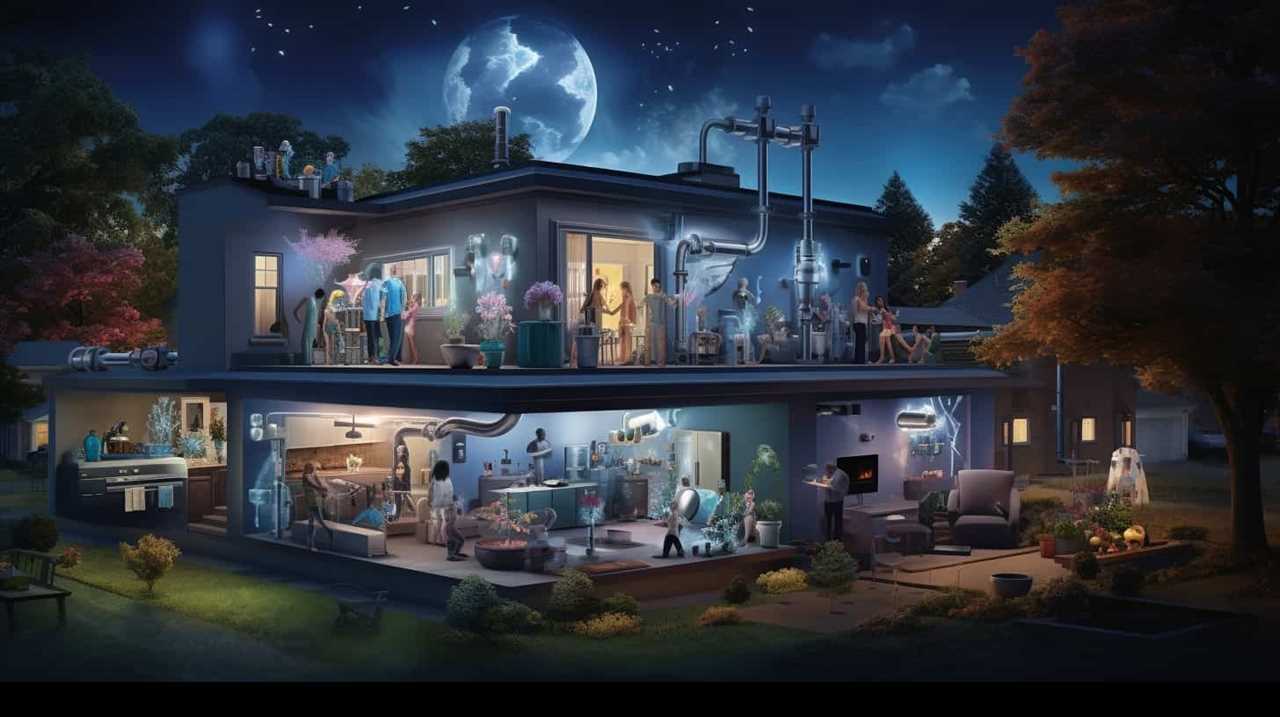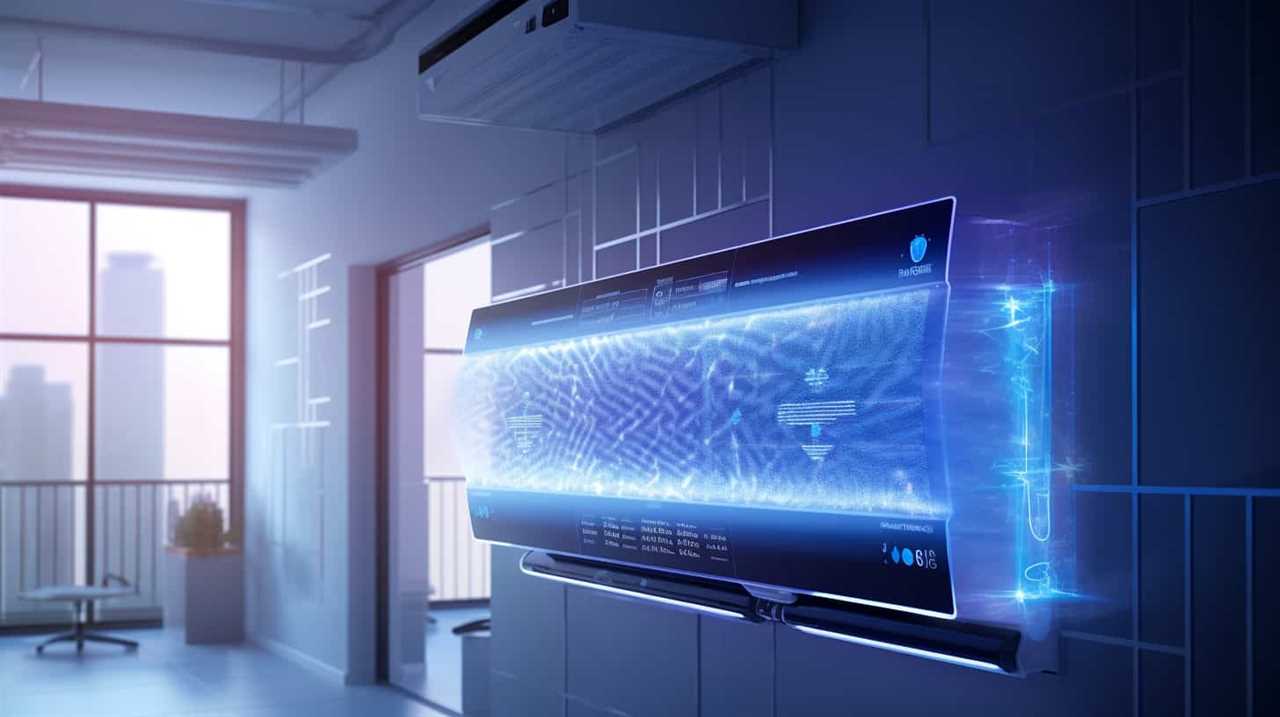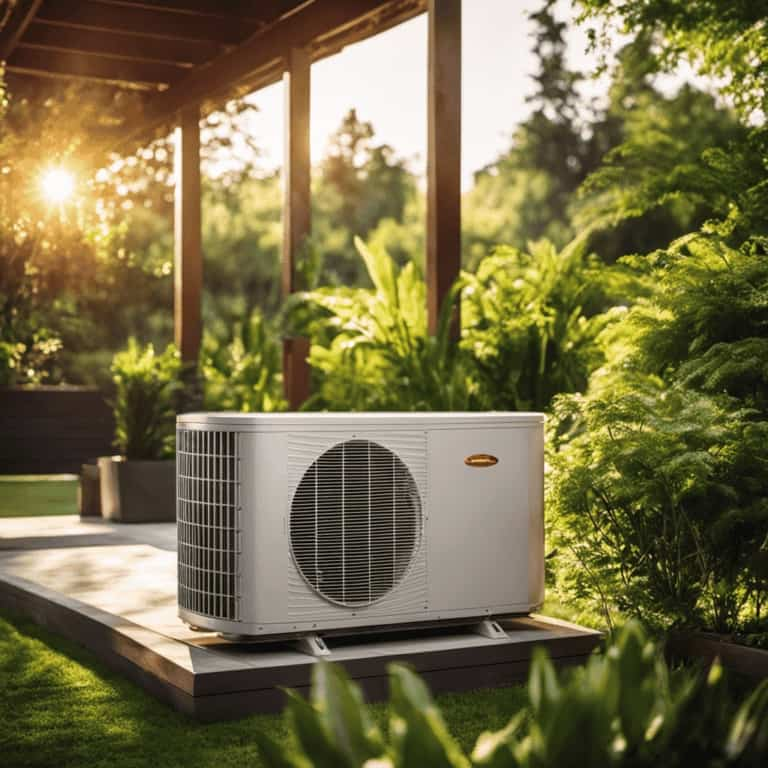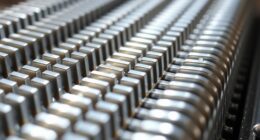We understand your enthusiasm for learning about energy-efficient architectural design, and heat pumps play a crucial role in achieving this objective. In this article, we will explore common questions about heat pumps to equip you with the necessary information to implement them successfully.
From understanding the different types of heat pumps to optimizing their efficiency in design and construction, we’ll cover it all.
Get ready to take your energy-efficient architecture to the next level with heat pumps.
Key Takeaways
- Heat pumps significantly reduce energy consumption in energy-efficient architecture.
- Heat pumps provide renewable heating by utilizing natural heat from the environment.
- Different types of heat pumps can be used in green buildings, including air-source, ground-source, and water-source heat pumps.
- When choosing a heat pump for energy-efficient design, factors such as energy efficiency, size, climate compatibility, noise level, and maintenance requirements should be considered.
The Benefits of Heat Pumps in Energy-Efficient Architecture
We love heat pumps because they significantly reduce energy consumption in energy-efficient architecture.

Heat pumps are an energy-saving technology that provides renewable heating for buildings. By utilizing the natural heat from the environment, heat pumps are able to transfer heat from one place to another, making them highly efficient. These devices extract heat from the air, ground, or water and then distribute it throughout the building using a refrigeration cycle.
This method of renewable heating not only reduces the reliance on fossil fuels but also lowers carbon emissions, making it an environmentally friendly option. Heat pumps can be integrated into various types of energy-efficient architectural designs, including passive houses and green buildings.
Their ability to efficiently provide heating and cooling makes them an essential component in achieving energy efficiency and sustainability in modern architecture.
Understanding the Different Types of Heat Pumps for Green Buildings
Let’s delve into the various types of heat pumps commonly used in green buildings. Heat pump technology is a key component of energy-efficient architectural design, as it utilizes renewable energy sources to provide heating and cooling.

There are three main types of heat pumps: air-source, ground-source, and water-source.
Air-source heat pumps extract heat from the surrounding air and transfer it into a building. They’re cost-effective and can be easily installed, making them a popular choice for green buildings.
Ground-source heat pumps, also known as geothermal heat pumps, extract heat from the ground through a series of underground pipes. They’re highly efficient and can provide both heating and cooling, making them a versatile option for green buildings.
Water-source heat pumps extract heat from a water source, such as a lake or river. They’re particularly effective in areas with a readily available water source.

Understanding the different types of heat pumps allows architects and designers to choose the most suitable option for their green building projects.
Key Factors to Consider When Choosing a Heat Pump for Energy-Efficient Design
When selecting a heat pump for energy-efficient design, there are several key factors to consider. Ensuring the right heat pump is chosen is crucial in achieving optimal energy efficiency in heating. Below is a table outlining the key factors to consider when selecting a heat pump for energy-efficient design.
| Factors to Consider | Description |
|---|---|
| Energy Efficiency | Look for a heat pump with a high coefficient of performance (COP) and a high Seasonal Energy Efficiency Ratio (SEER) rating. These indicate the heat pump’s ability to efficiently convert energy into heat. |
| Heat Pump Size | Choose a heat pump that is appropriately sized for the space it will be heating. An oversized heat pump can lead to short cycling and reduced efficiency, while an undersized heat pump may struggle to adequately heat the space. |
| Climate Compatibility | Consider the climate in which the heat pump will be used. Different heat pumps are designed to perform optimally in specific temperature ranges. |
| Noise Level | Ensure the heat pump operates at a noise level that is acceptable for the intended space. |
| Maintenance Requirements | Consider the maintenance requirements of the heat pump, including regular cleaning and filter replacement. |
Optimizing Heat Pump Efficiency in Architectural Planning and Construction
To achieve optimal heat pump efficiency in architectural planning and construction, we must consider various strategies and techniques.
The following are key considerations for heat pump sizing and placement:

- Properly sizing the heat pump system based on the heating and cooling loads of the building is essential to ensure efficient operation and avoid energy waste.
- Placing the heat pump unit in a well-ventilated and easily accessible location allows for optimal airflow and maintenance.
- Minimizing the distance between the heat pump and the conditioned spaces reduces heat loss through the distribution system.
- Proper insulation of the ductwork and piping helps to minimize heat transfer and maintain the desired temperatures.
By carefully considering these factors, architects and builders can optimize heat pump efficiency in their designs, resulting in energy-efficient buildings.
Now, let’s move on to discuss the common challenges and solutions for incorporating heat pumps in energy-efficient architecture.
Common Challenges and Solutions for Incorporating Heat Pumps in Energy-Efficient Architecture
Overcoming common challenges and finding effective solutions are crucial in successfully incorporating heat pumps in energy-efficient architecture.
One of the main challenges is the sizing of heat pumps to meet the heating and cooling demands of the building. Improper sizing can lead to inefficient operation and decreased energy savings. A solution to this challenge is conducting a detailed analysis of the building’s heating and cooling loads, taking into account factors such as insulation levels, air leakage, and climate conditions.

Another challenge is the integration of heat pumps with other HVAC systems in the building. Achieving a seamless integration requires careful coordination and design to ensure optimal performance and energy efficiency.
Additionally, noise generated by heat pumps can be a concern. Installing sound insulation or locating the heat pumps away from noise-sensitive areas can mitigate this challenge.
Frequently Asked Questions
How Much Does a Heat Pump Cost to Install and Maintain in an Energy-Efficient Building?
Installing and maintaining a heat pump in an energy-efficient building incurs costs. These costs include heat pump installation costs and ongoing maintenance expenses. It is important to factor these expenses into the overall budget for the project.
Can Heat Pumps Be Used in All Types of Climate Conditions?
Heat pumps can be used in various climate conditions, but they face challenges in extreme climates. Tropical regions, for example, may require additional measures to ensure optimal performance. Adaptations must be made to address humidity and temperature control.

Are There Any Government Incentives or Rebates Available for Installing Heat Pumps in Energy-Efficient Architecture?
Government incentives and available rebates can provide financial support for the installation of heat pumps in energy-efficient architecture. These incentives encourage the adoption of sustainable practices and help offset the initial costs of implementing heat pump systems.
How Long Does It Typically Take for a Heat Pump to Pay for Itself in Energy Savings?
On average, it takes a heat pump several years to pay for itself in energy savings. The payback period depends on various factors such as heat pump efficiency, energy costs, and climate conditions.
Can Heat Pumps Be Integrated With Other Renewable Energy Sources, Such as Solar Panels or Geothermal Systems?
Integration possibilities, benefits, and drawbacks of combining heat pumps with solar panels or geothermal systems vary. Solar panels can supplement the electricity needed to power heat pumps, while geothermal systems can enhance their efficiency. However, costs and compatibility should be considered.
Conclusion
In conclusion, heat pumps are a valuable addition to energy-efficient architectural design. They provide numerous benefits, such as reducing energy consumption and greenhouse gas emissions.

Understanding the different types of heat pumps available is important when considering their implementation in green buildings. Factors such as efficiency, sizing, and installation should be carefully considered to ensure optimal performance.
Despite some challenges, incorporating heat pumps in energy-efficient architecture can greatly contribute to a sustainable and comfortable living environment. It’s like adding a jet engine to your home’s heating and cooling system!









